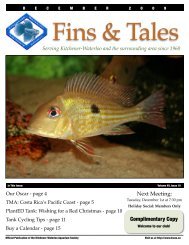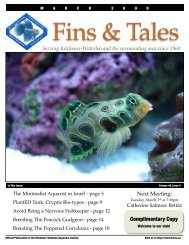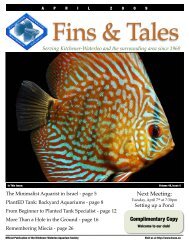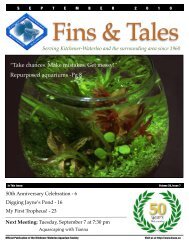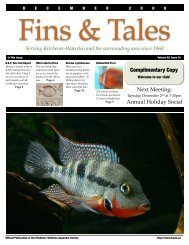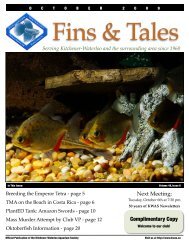June 2009 - Kitchener Waterloo Aquarium Society
June 2009 - Kitchener Waterloo Aquarium Society
June 2009 - Kitchener Waterloo Aquarium Society
Create successful ePaper yourself
Turn your PDF publications into a flip-book with our unique Google optimized e-Paper software.
J U N E 2 0 0 9<br />
So what did I learn? Heiko normally collects Discus at night<br />
when they float up nearer the surface and can be scooped up by<br />
flashlight. In the light of day they may dive to 4 and 5 metres of<br />
water where they hover in schools for protection. Eighty species<br />
were collected in the Jutai river including a new and interesting<br />
Angelfish, a myriad of characins and catfishes, and the smallest<br />
needlefish in the world, the Belonion.<br />
Next up, Heiko returned with a unique trip to North Eastern<br />
India. Nagaland as the area between the Himalayas and the<br />
waters of the Bay of Bengal is called, is off-limits even to many<br />
of India’s citizenry. The Brahmaputra River winds down 4000<br />
km from Tibet into this indigenous region. An interesting<br />
revelation was that two familiar genera share an identical<br />
habitat but on two very different continents. A biotope shot<br />
from South America’s Apistogramma family could easily be<br />
confused for one where India’s Badis fishes can be found.<br />
A diverse collection of fishes from Aplocheilus (killifishes), to<br />
dwarf Channa (snakeheads) jumped to the projector screen as<br />
did Heiko’s challenge to find the fish in an image of a dip net he<br />
had lifted from a Nagaland stream. The projection screen may<br />
have been huge but not sufficient for any among us to spot a<br />
fully grown Darion, which at breeding size is a mere 9 mm in<br />
length.<br />
Gary Lange got the coveted ‘first speaker of the day’ spot<br />
Saturday morning and led with how to photograph your fish<br />
and embarrass your friends (translation blackmail perhaps?)<br />
Aside from the usual primer on what Fstop and ISO should<br />
mean to the wannabe fish photographer, Gary suggested a few<br />
tips for those early risers who caught his opening act. Firstly<br />
you need a digital camera with a manual focus feature to be<br />
truly successful – now he tells me after I’ve replaced both of our<br />
cameras already. Next, shoot fishes at the higher Fstop settings<br />
(16-22) as you will enjoy more of the fish being in focus and<br />
always, always, always focus on the eye of the fish. Nothing<br />
else will save your photo if the eye is out of focus. Lastly you<br />
cannot spend enough time on acclimating the fishes and<br />
cleaning the glass before hand. There is always Photoshop but<br />
imagine cleaning up the accompanying photo. Lastly if you’re<br />
doing digital – shoot lots of shots, says Gary, digital film is free.<br />
Bob Fenner made his debut with a slide that teased ‘Algae can<br />
be your friend’. Bob proved a consummate entertainer and<br />
teacher as he drew his audience through an understanding of<br />
micro and macro algae, from diatoms to kelps and from<br />
phenomena known as red tides to aegagropila balls which<br />
themselves are an algae but are purchased by hobbyists to outcompete<br />
lesser algaes and thereby suppress them from our<br />
display aquaria.<br />
Bob’s hints during this session were to understand the specific<br />
algae in order to plan its demise. Frozen foods for example can<br />
release unwanted nutrients into the aquarium while prethawing<br />
and rinsing those brine shrimp is a simple<br />
preventative. Bob also advocated having a duplicate set of<br />
sponge filters so that a fresh filter can be inserted to the<br />
aquarium while the used one is cleaned and permitted to air<br />
dry between uses.<br />
6





